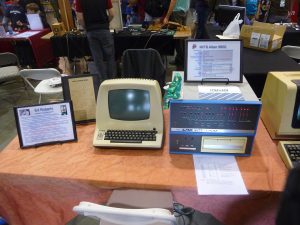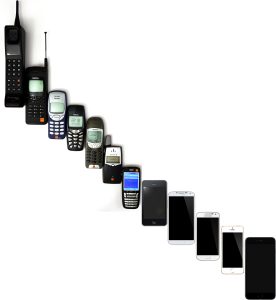20 Communication Technologies of Generation X
Evan Hashley
Keywords
- Communication technology – to communicate with others in all settings, no matter the social class.
- Email – when it came out and became available to everyone, was one of the most common ways to communicate with someone as it was used as both a personal way to communicate as well as a communication tool in the business world.
- Cell phone – evolved into the smartphone that is currently being used by the generation today and is constantly being updated with new and different technology and features.
Learning Objectives
- Know the two important communication technologies invented in generation X.
- Know why these two technologies are important to society.
- Know how these two technologies have evolved into what they are today.
20.1 Introduction
Throughout the day, billions of people all around the world use various types of communication technology to communicate with others in all settings, no matter the social class. Communication technology has evolved drastically over time since the first pieces of it were created. There is always new technology coming out to try and better the way that we communicate with others. In generation X, there were two pieces of technology that revolutionized the way we communicate.
The first revolutionary piece of technology that came from generation X was Email. Email, when it came out and became available to everyone, was one of the most common ways to communicate with someone as it was used as both a personal way to communicate as well as a communication tool in the business world. Email is still prominently used today, as billions of emails are sent and received around the world every day.
The other revolutionary piece of technology that came from generation x was the cell phone. Everyone nowadays has a cell phone as it is almost required to have to accomplish daily tasks. When the cell phone first came out, it was a device that only the wealthy had as it had a hefty price tag (as it still does today). The original brick-looking cell phone evolved into the smartphone that is currently being used by the generation today and is constantly being updated with new and different technology and features.

“Classic Computer: MITS Altair 8800” by Mark Atwood is licensed under CC BY-NC 2.0
20.2 Email
Key Takeaway
Billions of emails are sent and received every day throughout the world. It is hard to imagine a world without email. However, email has only been around for about 50 years. In 1978 V. A. Shiva Ayyadurai, a 14-year-old working as a research scholar at the University of Medicine and Dentistry of New Jersey, invented email. Ayyadurai was challenged by the man who hired him, Dr. Leslie P. Michelson, to create an electronic version of the traditional interoffice mail system. Ayyadurai accepted the challenge and created the Email system that we still use today by using computer hardware, an operating system, terminals and keyboards, a network, a programming language, and a database system.
At first, email became an idea for an alternative way to communicate between coworkers within a company. It was successful in its use within the company, so Ayyadurai was urged to make email able to be used by the public. It was made public after working with different operating systems. When it was made public, it was extremely successful and became more and more popular as time went on. Email is still prominently used today as a personal way of communication as well as a way to communicate with coworkers and other people in business.

“Writing a letter” by NTB scanpix is licensed under CC BY-NC 4.0
20.3 The Cell Phone
Key Takeaway
In today’s day and age, everyone needs a cell phone to do various things that help make it through the day. However, it was only about 50 years ago that the first cell phone was even created. On April 3, 1973, the first cell phone was created by an Engineer at Motorola, Martin Cooper. This cell phone was called the Motorola DynaTAC 8000x. The cell phone that we know today is a completely different change from the original cell phone that came out. The Motorola DynaTAC 8000x was nicknamed “The Brick,” since it was in the shape of a brick. Unlike cell phones nowadays, the brick was not able to be put in a pocket or easily concealable. Despite its size, the brick was still an extremely revolutionary piece of technology that changed the way that we can communicate with others.
When the cell phone came out, it amazed people how you could call someone on the phone without having to worry about staying next to a wall or table where a traditional phone would be located at. You could call someone and go wherever you wanted to have a conversation with them. However, most people did not obtain a cell phone until many years after they came out. They were pricey and hard to get until many different companies were making them. In fact, cell phones really were not prominent until the 90s and early 2000s.

“Motorola DynaTAC” by Peter E is licensed under CC BY-NC-SA 2.0
20.4 Impact on Generation X
Key Takeaway
Communication technologies had a major impact on generation X. Both cell phones and email revolutionized the way that generation X communicated with one another. That effect has carried on throughout the lives of those born during generation X. Along the way, there have been many improvements, but also some setbacks. As these technologies become more advanced and prominent in the world, there are both many positive and also negative effects that result from these technologies.
20.4.1 Positive Effects
Like most technology that is invented, these communication technologies had an overall very positive impact on generation X. Cell phones were a revolutionary piece of technology as they made making a phone call more enjoyable as you did not have to worry about staying within the cord range of a traditional phone and could call someone outside of your house while running errands. The email was also revolutionary as it made sending large amounts of information to both businesses and friends easier. No more having to write a letter or send a memo in the mail. You could instantly send an email which would save days of the information being relayed to one another.
20.4.2 Negative Effects
With all of these positive effects, there are, of course, negative effects. Email, for example, has gotten worse as time has gone on with spam mail. Some of it is just annoying advertisements, but some of it is harmful to people that try and steal others’ information by pretending to be someone that they are not to get the information. Cell phones have also had negative effects. In the early days of the cell phone being invented, many people used having the cell phone as a wealth symbol as they were priced at about $4,000, which is equivalent to about $11,000 in today’s money. The cell phone has turned into a device that younger people these days become severely addicted to. People now rely on cell phones to allow them to accomplish tasks throughout the day.
20.5 How Communication Technology Has Evolved
Key Takeaway
Both email and cell phones are still extremely useful today. Almost everyone has and uses email as well as cell phones. Both of these are now required to have for almost any job as they are used to send out important information as well as being used to communicate with others.
The email has actually not changed all that much from when it was originally created in 1978. The same concepts are used from the original creation, such as; the “to,” the “from,” the “cc,” the subject line, the body, and the attachments. The only thing that changes with Email is the platforms that it is offered on (Google, Yahoo, Microsoft, etc.).
The cell phone has completely changed from the original Motorolla brick phone. It went from the original to a smaller version with an extendable antenna with a digital screen. Then to an even smaller version, this time no antenna. Next came the flip phone era, a smaller phone that flipped open and close with a digital screen. After the flip phone came the smartphone which we know today. It started with Blackberry, which was a non-touchscreen smartphone. Then came the smartphone that we know today, the Apple iPhone, with a touch screen. This platform of phones came out in 2007 and has been improved upon each year since.

“Mobile Phone Evolution 1992-2014” by Wikimedia Commons is in the Public Domain
How the Cell Phone Helped the Ford Family
Amy Ford of the Ford family was born in 1973. Growing up in a small town in West Virginia, the Ford parents both had jobs that were almost a 2-hour drive from home. That meant when they were 2 hours away from home at work, Amy and her brother had no way of talking to their parents when at home with their babysitter. That was the reality until the cell phone was invented. When the cell phone came out, the Ford family was luckily able to get one in the late 70s. This meant that when they were gone 2 hours away from work, they could use their cell phone to call the home phone and check on their children. Amy vividly remembers first getting the cell phone and being able to talk to her parents while they were at work. She said that being able to talk to her parents on the phone made her the happiest child she could be.
Chapter Summary
Communication technology is very important. Both in today’s society and back in generation X as well. The cell phone and email were both very important communication technologies that were invented during generation X. These technologies not only impacted generation X but impacted every generation after that. After many improvements and redesigns throughout the years, these technologies are still an important part of communicating today.
Review Questions
Food For Thought
- Think of someone you know that was born in generation X. Ask them what cell phones and email meant to them growing up.
- What do you think the future of these two technologies is? Do you think they will eventually be replaced by something else or keep being improved on?
References
Aamoth, D. (2012). The man who invented email. Time Magazine: Techland.
Bell, A. G., & Arrive, M. P. The Conception of the Smartphone and it’s Effects.
Calvo-Porral, C., & Pesqueira-Sanchez, R. (2020). Generational differences in technology behaviour: comparing millennials and Generation X. Kybernetes.
Grencíková, A., & Vojtovic, S. (2017). Relationship of generations X, Y, Z with new communication technologies. Problems and Perspectives in Management, (15, Iss. 2 (cont. 3)), 557-563.
Losyk, B. (1997). Generation X: What they think and what they plan to do. The futurist, 31(2), 39.
Michelson, L. P., Field, R., Nightingale, D. J., Song, S., Feuerman, M., & Corson, R. L. Invention of Email in Newark, NJ (1978): The First Email System.
Murphy, T. (2013). 40 Years After the First Cell Phone Call: Who Is Inventing Tomorrow? s Future?. IEEE Consumer Electronics Magazine, 2(4), 44-46.
“The Invention of Mobile Phones.” Science Museum, November 12, 2018. https://www.sciencemuseum.org.uk/objects-and-stories/invention-mobile-phones#:~:text=Martin%20Cooper%2C%20the%20engineer%20from,for%20wealthy%20financiers%20and%20entrepreneurs.
Zickuhr, K. (2011). Generations and their gadgets (p. 2013). Washington, DC: Pew Internet & American Life Project.

